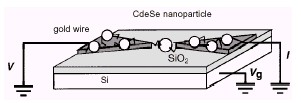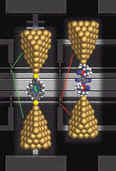|
The invention of the transistor in 1948 by John Bardeen and William Shockley, triggered a new era in electronics. The trend since then has |
|
|
been to create smaller and smaller product using fewer chips of greater complexity and smaller 'feature' sizes. The development of integrated circuits and storage devices have continued to progress at an exponential rate. At present it takes two or three years for each successive halving of component size. |
|
|
However, the technologies currently in use have fundamental limits below, which the devices no longer function in a predictable manner. For instance, oxide layers used in Complimentary Metal Oxide Semiconductors (CMOS) devices are becoming so thin that leakage currents are conducted quantum mechanically by electron tunnelling. Therefore, replacement technology to advance miniaturisation even further down, eventually to the dimensions of single atoms and molecules, is keenly sought. In 1985, Dmitri Averin and Konstantin Likharev, proposed the idea of a new three-terminal device called a single-electron tunnelling (SET) transistor. Two years later Theodore Fulton and Gerald Dolan at Bell Labs in the US fabricated such a device and demonstrated how it operates. Since then much research has gone into this area and better single-electron devices has been fabricated. |
|
repulsive Coulombic interactions between the electrons and energy is required to add an extra electron. This energy cost can be tuned to zero by applying a voltage to the gate electrode. The electrostatic potential at this gate will be such that an extra electron can hop from the source |
|
onto
the molecule. However, due to Coulomb repulsion, a second, extra,
electron cannot hop on at the same time. The first electron must
leave the molecule, moving into the drain before the next electron
can enter. This one-by-one electron motion, is known as the
single-electron quantum tunneling.
|
|
The creation an ultrafast, single-electron transistor would lead to the development of "quantum" computers with supercomputer powers and the size of a thumbtack. However, there is still a long road ahead before atomic or molecular transistors can be assembled into viable, dense, fast logic-circuits. Currently these single-electron devices are still no competition for silicon transistors. But they will serve both scientifically, for studying electron motion through nanoscale objects, and technologically, for developing chemical techniques with which to fabricate electronic devices on single molecules.
|


